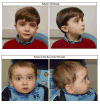Two siblings with alternate unbalanced recombinants derived from a large cryptic maternal pericentric inversion of chromosome 20
- PMID: 20101690
- PMCID: PMC2840621
- DOI: 10.1002/ajmg.a.33219
Two siblings with alternate unbalanced recombinants derived from a large cryptic maternal pericentric inversion of chromosome 20
Abstract
Two brothers, with dissimilar clinical features, were each found to have different abnormalities of chromosome 20 by subtelomere fluorescence in situ hybridization (FISH). The proband had deletion of 20p subtelomere and duplication of 20q subtelomere, while his brother was found to have a duplication of 20p subtelomere and deletion of 20q subtelomere. Parental cytogenetic studies were initially thought to be normal, both by G-banding and by subtelomere FISH analysis. Since chromosome 20 is a metacentric chromosome and an inversion was suspected, we used anchored FISH to assist in identifying a possible inversion. This approach employed concomitant hybridization of a FISH probe to the short (p) arm of chromosome 20 with the 20q subtelomere probe. We identified a cytogenetically non-visible, mosaic pericentric inversion of one of the maternal chromosome 20 homologs, providing a mechanistic explanation for the chromosomal abnormalities present in these brothers. Array comparative genomic hybridization (CGH) with both a custom-made BAC and cosmid-based subtelomere specific array (TEL array) and a commercially available SNP-based array confirmed and further characterized these rearrangements, identifying this as the largest pericentric inversion of chromosome 20 described to date. TEL array data indicate that the 20p breakpoint is defined by BAC RP11-978M13, approximately 900 kb from the pter; SNP array data reveal this breakpoint to occur within BAC RP11-978M13. The 20q breakpoint is defined by BAC RP11-93B14, approximately 1.7 Mb from the qter, by TEL array; SNP array data refine this breakpoint to within a gap between BACs on the TEL array (i.e., between RP11-93B14 and proximal BAC RP11-765G16).
Copyright 2010 Wiley-Liss, Inc.
Figures
Similar articles
-
Identical cryptic partial monosomy 20pter and trisomy 20qter in three adult siblings due to a large maternal pericentric inversion: detection by MLPA and breakpoint mapping by SNP array analysis.Am J Med Genet A. 2009 Oct;149A(10):2226-30. doi: 10.1002/ajmg.a.32967. Am J Med Genet A. 2009. PMID: 19725130
-
Paracentric inversion of chromosome 2 associated with cryptic duplication of 2q14 and deletion of 2q37 in a patient with autism.Am J Med Genet A. 2010 Sep;152A(9):2346-54. doi: 10.1002/ajmg.a.33601. Am J Med Genet A. 2010. PMID: 20684015 Free PMC article.
-
Cytogenetic and molecular cytogenetic findings in 43 aneurysmal bone cysts: aberrations of 17p mapped to 17p13.2 by fluorescence in situ hybridization.Mod Pathol. 2004 May;17(5):518-25. doi: 10.1038/modpathol.3800090. Mod Pathol. 2004. PMID: 15044915
-
Duplication of 20qter and deletion of 20pter due to paternal pericentric inversion: patient report and review of 20qter duplications.Am J Med Genet A. 2014 Aug;164A(8):2020-4. doi: 10.1002/ajmg.a.34020. Epub 2014 Jun 20. Am J Med Genet A. 2014. PMID: 24954807 Review.
-
Molecular characterization of a novel, de novo, cryptic interstitial deletion on 19p13.3 in a child with a cutis aplasia and multiple congenital anomalies.Am J Med Genet A. 2010 Dec;152A(12):3148-53. doi: 10.1002/ajmg.a.33738. Am J Med Genet A. 2010. PMID: 21108400 Review.
Cited by
-
A case of partial trisomy 20p resulting from meiotic recombination of a maternal pericentric inversion.Ann Lab Med. 2012 Jan;32(1):91-4. doi: 10.3343/alm.2012.32.1.91. Epub 2011 Dec 20. Ann Lab Med. 2012. PMID: 22259786 Free PMC article.
-
A genotype-first approach for the molecular and clinical characterization of uncommon de novo microdeletion of 20q13.33.PLoS One. 2010 Aug 27;5(8):e12462. doi: 10.1371/journal.pone.0012462. PLoS One. 2010. PMID: 20805988 Free PMC article.
-
Short report: Twins with 20p13 duplication. Case report and comprehensive literature review.Mol Genet Genomic Med. 2024 May;12(5):e2436. doi: 10.1002/mgg3.2436. Mol Genet Genomic Med. 2024. PMID: 38738460 Free PMC article. Review.
-
A novel de novo 20q13.32-q13.33 deletion in a 2-year-old child with poor growth, feeding difficulties and low bone mass.J Hum Genet. 2015 Jun;60(6):313-7. doi: 10.1038/jhg.2015.22. Epub 2015 Mar 12. J Hum Genet. 2015. PMID: 25761574
References
-
- Anderlid BM, Schoumans J, Anneren G, Sahlen S, Kyllerman M, Vujic M, Hagberg B, Blennow E, Nordenskjold M. Subtelomeric rearrangements detected in patients with idiopathic mental retardation. Am J Med Genet. 2002;107:275–284. - PubMed
-
- Ardalan A, Prieur M, Choiset A, Turleau C, Goutieres F, Girard-Orgeolet S. Intrachromosomal insertion mimicking a pericentric inversion: molecular cytogenetic characterization of a three break rearrangement of chromosome 20. Am J Med Genet A . 2005;138A:288–293. - PubMed
-
- Baker E, Hinton L, Callen DF, Altree M, Dobbie A, Eyre HJ, Sutherland GR, Thompson E, Thompson P, Woollatt E, Haan E. Study of 250 children with idiopathic mental retardation reveals nine cryptic and diverse subtelomeric chromosome anomalies. Am J Med Genet. 2002;107:285–293. - PubMed
-
- Ballif BC, Sulpizio SG, Lloyd RM, Minier SL, Theisen A, Bejjani BA, Shaffer LG. The clinical utility of enhanced subtelomeric coverage in array CGH. Am J Med Genet A. 2007;143A:1850–1857. - PubMed
-
- Baroncini A, Rivieri F, Capucci A, Croci G, Franchi F, Sensi A, Battaglia P, Aiello V, Calzolari E. FISH screening for subtelomeric rearrangements in 219 patients with idiopathic mental retardation and normal karyotype. Eur J Med Genet. 2005;48:388–396. - PubMed
Publication types
MeSH terms
Grants and funding
LinkOut - more resources
Full Text Sources
Miscellaneous



